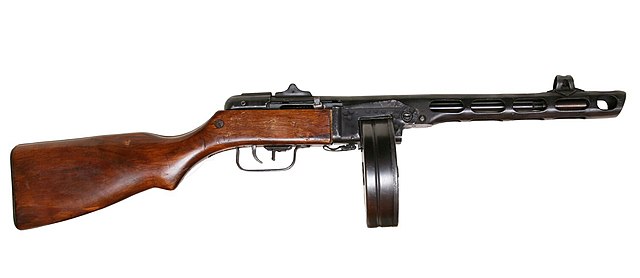The PPSh-41 is a selective-fire, open-bolt, blowback submachine gun that fires the 7.62×25mm Tokarev round. It was designed by Georgy Shpagin of the Soviet Union to be a cheaper and simplified alternative to the PPD-40.
PPSh-41 with a 71-round drum magazine
A 1942 PPSh-41 with a 35-round box magazine
PPSh (left) compared to PPS (right) box magazine
Soviet PPSH-41 submachine gun, Fort Lewis Military Museum, Fort Lewis, Washington, U.S. - part of a display of the weapons of the Korean War
A firearm is said to fire from an open bolt or open breech if, when ready to fire, the bolt and working parts are held to the rear of the receiver, with no round in the chamber. When the trigger is actuated, the bolt travels forward, feeds a cartridge from the magazine or belt into the chamber, and fires that cartridge in the same movement. Like any other self-loading design, the action is cycled by the energy released from the propellant, which sends the bolt back to the rear, compressing the mainspring in readiness for firing the next round. In an open-bolt gun firing semi-automatically, the bolt is caught and held at this point by the sear after each shot; and in automatic open-bolt fire, it's caught and held in this manner whenever the trigger is released. In contrast to this, in closed-bolt guns, the trigger and sear do not affect the movement of the bolt directly.
A MAC-10 submachine gun





